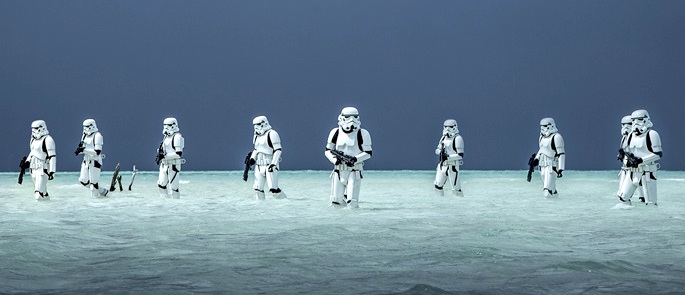
If the box office receipts are to be believed, you’ve already seen Rogue One: a Star Wars Story. So rather than a full review, I thought I’d offer a few thoughts on this, the intertestamental literature of the Star Wars saga:
- This is the most geek-tastic Star Wars film ever: “THRILL as Jyn Erso and Cassian Andor sift through the structural engineering files of the Galactic Empire! GASP as they try to upload the Death Star plans to a Rebel starship. Will there be enough bandwidth for such a massive file?”
- Furthermore, although the weapons engineering achievements of the Empire are monumental, the safety engineering standards continue to be, shall we say, not up to code. As always in Imperial-designed facilities, fall hazards are everywhere, and there’s not a railing or caution sign to be found. This just goes to show the first thing evil people do when they take over the galaxy is to banish workplace safety standards.
- This film also answers one of the great debates of my generation, first posed in the Kevin Smith film Clerks: What happens to all the contractors brought in to build the Death Star when the rebels attack? Answer: they’re either shot by stormtroopers for intelligence leaks that aren’t their fault, or blown up by friendly fire. But hey, “Any contractor working on that Death Star knew the risk involved. If they got killed, it’s their own fault.”
- All the robots in this galaxy are apparently programed by gay men. K-2SO (voiced by Alan Tudyk) is the most entertainingly bitchy android since Rupert Everett. And of course we get a cameo from longtime companion droids C3PO and R2D2, who’ve been bickering like an married couple since 1977.
- Meanwhile, what was up with Sassy Vader? “Be careful not to choke on your aspirations, director”?
- The Jedi Church has a new saint in Chirrut Îmwe, played by Hong Kong action star Donnie Yen. He’s blind and finds his way around by the Force. And he can also kill stormtroopers with a kind of laser bo staff. He continually chants, “I am one with the Force, the Force is with me.” I wasn’t really sure if this clumsy mantra was supposed to show religious devotion or if this was all he knew to do since there were no Jedi around to train him.

- Perhaps the most interesting way Star Wars is further resembling a religion is in its expanding canonicity. What we have in Rogue One is the intertestamental literature, the Maccabees of Star Wars. In the next few years we’ll see origin stories for Han Solo and Boba Fett. These one-off Star Wars Story films seem to fulfill the role of midrash. Maybe, years from now, someone will dig up the equivalent of the Dead Sea Scrolls on Skywalker Ranch and it will change our whole outlook on the canon.
- There’s a lot we’ve seen before in Rogue One—space battle combined with land battle where land battle has to win in order to disable something so the rebels can win the space battle. But it has never been so gorgeously shot. Director Gareth Edwards and cinematographer Greig Fraser have changed the way images are framed and how the camera moves, making the massive star destroyers look monumental and unwieldy; the way action unfolds, showing the real consequences of war on human bodies; and contrasting the cold technological sheen of the Empire against magnificent natural beauty, especially in the opening scenes on Planet Lah’mu (Iceland) and Scarif (The Maldives).
- Rogue One, for the first time, introduces moral ambiguity into the movie series. This is why I suspect so many fans are willing to overlook the cludgy plot and underdeveloped characters. “I’ve done terrible things on behalf of the Rebellion,” says Cassian Andor (Diego Luna) intelligence officer and willing assassin for the Rebels. Compare Andor’s cold-blooded killing of an injured fellow spy to prevent exposure of their mission to all that squeamishness about Han Solo shooting Greedo first in the original Star Wars.

- Morals in Rogue One have lost the easy good versus evil delineation of the previous seven films. One visual cue that speaks volumes about this muddy moral universe is in the costumes of two of the characters. Director Krennic (Ben Mendelsohn) the officer in charge of the Death Star project, is dressed in a white tunic and cape. White is usually associated with good guys in films. On the other hand, the leader of the violent Rebel faction, the Sentinels, Saw Gerrera (Forest Whitaker) has become a DIY Darth Vader. Limbs have been replaced by ill-fitting metal parts, and he uses a respirator, producing the eerie metallic breathing we associate with Vader. Although Krennic is clearly evil in intent and sneers in his white uniform like he’s been caught in a fashion faux-pas after Labor Day, Gerrera is a more ruthless and dangerous figure than we’re used to seeing with the “good guys.”
- Rogue One shows the difficulty of creating political unity to confront an existential threat to goodness and democracy—a theme with implications for our own little corner of the galaxy right now. But it also presents the possibility that people can go so far in the pursuit of righteousness that they can cross over into violence and destruction—that we can be so obsessed in our attempt to win victory for the Light Side that we can cross over to the Dark Side. To do this is to forget that God…er…ahem…the Force, is what ultimately defeats evil, not ourselves.

